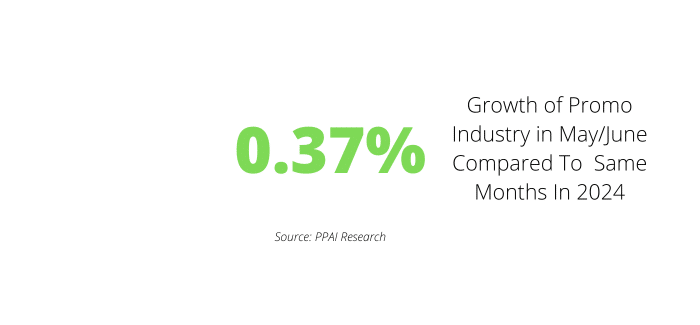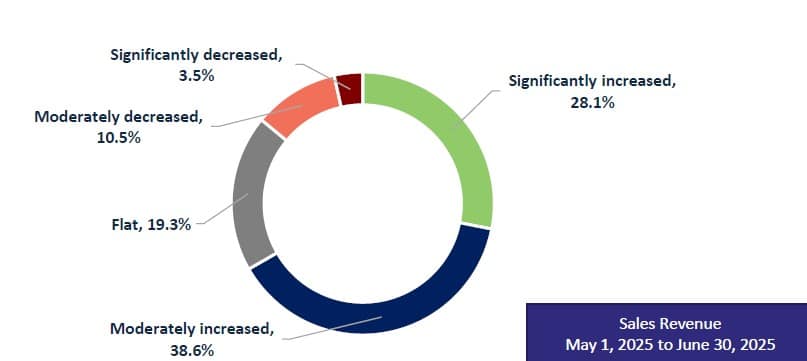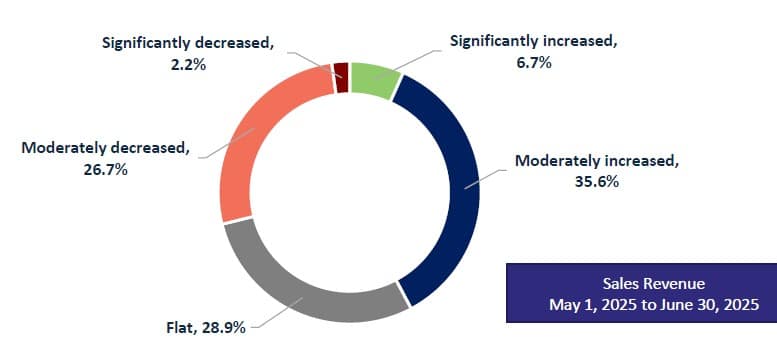Halfway through 2025, the promo industry’s year-over-year growth rate has gone in only one direction: downward. Technically, promo’s sales revenue is still growing year-over-year, but that margin is becoming razor-thin and is being significantly outpaced by inflation.
- PPAI Research’s most recent bi-monthly survey has confirmed that industry revenue grew by 0.37% in May and June compared to the same two-month period in 2024. This is down slightly from 0.42% in March and April.
- By comparison, the current inflation rate is 2.7%, creating a potential strain on promo businesses for which costs are rising faster than revenue.
- Continuing a trend throughout 2025, this slowed growth is hitting suppliers harder than distributors, though that gap is showing signs of narrowing.

This trend took shape in January and February’s bi-monthly study. Essentially all of 2024 represented a slow but consistently upward growth rate that looked primed to eventually top the 3% mark. A harsh reality kicked in with the January and February findings, which showed that year-over-year growth had dipped significantly below 1%, representing worse returns than any two-month stretch in 2024. Each bi-monthly study since then has dipped a little bit more.
“With inflation at 2.7% and tariff uncertainty persisting, many businesses are finding it difficult to grow fast enough to protect margins,” says Alok Bhat, market economist and PPAI’s research and public affairs lead.
- The latest revenue data isn’t cultivated from the same methodology as the annual U.S. Distributor Sales Volume Estimate, which polls U.S. distributors of all sizes.
- Rather, the current assessment stems from the aggregated results of PPAI 100 distributors and suppliers responding to a flash survey.
It’s worth noting that the promo industry is not alone in facing slowdowns at the threat of tariffs’ impacts on the supply chain. The year to this point, however, has potentially implied that promo will have to learn to adapt and grow within uncertainty.

Alok Bhat
Market Economist & Research and Public Affairs Lead, PPAI
Distributor Findings
In the first four months of the year, the data showed that the industry’s slowed growth was hitting the suppliers significantly harder than distributors. In March and April, for example, 81% of distributors reported revenue growth, with more than a third (35%) claiming significant gains in revenue, while supplier numbers looked considerably less rosy. Given promo’s supply chain, this did not seem a sustainable dynamic.
- Distributors are still faring much better than suppliers in May/June, but those reporting revenue growth has decreased to 66.7%, with the slight majority of those labeling it a moderate increase.

The 14% reporting a decrease in revenue (and 3.5% reporting a significant decrease in revenue) are only slight upticks from March/April, but they remain concerning and fuel worry that distributor growth is concentrated among specific firms and broadly uneven as a whole.
It’s also worth noting that while May and June did include tariffs that did not exist in 2024, much of promo and other global industries were reacting to the uncertainty of threatened tariffs and consistently extended deadlines of massively impactful tariffs. While this uncertainty has been consequential, threatened tariffs on trade partners such as Mexico, Canada and the EU could bring greater pressures if they come to fruition.
“These effects [of decreased revenues] may become more pronounced later in the year as tariff and inflation pressures filter through,” Bhat says.
- As things stood in May/June, 70.9% of distributors reported increased inventory costs, though nearly all of that amount (69.1% of the total) consider it a moderate increase in costs.
- It is worth noting that many distributors took actions as the threat of tariffs surfaced, such as stockpiling supplier inventory, which may be beginning to show signs of dwindling for some halfway through 2025.
In June, when this data was collected, Jake Himelstein, president of BAMKO, PPAI 100’s No. 4 distributor, told PPAI Media, “At this point, we’re in a holding pattern waiting for the results of the appeal before we take any action,” speaking on a Supreme Court decision on one of many consequential tariffs President Trump implemented.
RELATED: Randy Conley: Tips For Growth Despite Recession Fears
This may serve as a snapshot of the line of thinking that decision-makers have been forced into while navigating uncertainty and various price increases.
Inflation and cost pressures are not having a strong impact on distributor margins yet, according to the data:
- 21.1% of distributors reported margin declines, with very few (1.9%) describing it as significant.
- The majority (62.2%) of distributors say their margins haven’t been impacted by inflation yet.
- 9.6% reported margin gains.
While these margin numbers are not troubling, the same report concerning suppliers is considerably worse, which continues to suggest a lack of sustainable success on the distributor side of things.
“Reported stability may reflect temporary insulation, not true margin resilience,” Bhat says.
Supplier Findings
The number of suppliers reporting revenue growth has officially fallen below 50%:
- In May/June, only 42.3% of suppliers reported an increase in revenue.
- That’s a drop of about 9% from March/April.
- It also lags behind distributors’ growth rate by a rate of 22%.

The data shows that that even many of the larger suppliers are not reporting significant increases in revenue. As noted in the distributor section, many distributors chose to stockpile inventory from suppliers in the months leading up to tariff discussions. Where that has left suppliers nearly half a year later, with prices rising, is a situation to monitor.
Notably, a considerable majority (84.4%) of suppliers are reporting rising procurement costs. Furthermore, nearly a third (31.1%) categorize them as significant increases.
“Rising procurement costs are directly feeding margin pressure, underscoring the challenge of protecting profitability in a low-growth environment,” Bhat says.
ICYMI: PPAI Research: Distributors Expanding Supplier Base Amid Volatility
Chris Anderson, a member of the PPAI Board of Directors and CEO of HPG, PPAI 100’s No. 4 supplier, which has a production presence in Mexico, told PPAI Media that the uncertainty surrounding tariffs has forced a long-term approach, and while certainly not ideal, the firm has avoided reacting too dramatically to new developments.
“HPG’s position throughout all the tariff uncertainty has been, and continues to be, one of focus on our long-term initiatives, being mindful to not become prisoners of the moment and avoiding meaningful decisions based on, what is likely to be, a temporary (likely mid-negotiation) position,” Anderson says.
Inflation and cost pressures are taking their toll on margins more severely than for distributors, according to the data:
- 60.5% of suppliers reported declining margins due to inflation.
- 37.2% say margins held steady at a mostly neutral rate.
- Only 2.3% of firms reported margin improvement.


